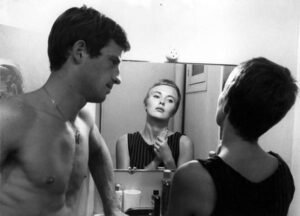Regarded as the manifesto of the New Wave even before its official release in March 1960, and likened to Orson Welles’s Citizen Kane for its groundbreaking visual style, À bout de souffle represented a significant departure from the conventions of traditional storytelling and continuity editing.
Among the most groundbreaking elements of Jean-Luc Godard’s inaugural feature film, the cinematography and utilization of authentic locations have frequently been linked with the innovative approach to filmmaking that has influenced numerous generations of independent directors on both sides of the Atlantic.
In an interview two years after À bout de souffle‘s premiere, Godard stated, ‘If we used a hand-held camera, it was simply for speed. I couldn’t afford to use the usual equipment, which would have added three weeks to the shooting.’
Nevertheless, the spontaneity and raw, documentary-like atmosphere achieved by filming in real locations and primarily relying on natural light were deliberate choices pursued by the aspiring filmmaker, even in the face of opposition.
Initially resistant to the producer’s decision to appoint Raoul Coutard as the director of photography, Godard embraced the idea upon realizing Coutard’s willingness to shoot the film in a documentary style. Coutard, renowned for his ability to capture fleeting moments of reality, had established himself as a war photographer in Indo-China during the 1950s, later becoming Pierre Schoendoerffer’s cameraman in challenging environments such as Vietnam and Afghanistan.
Significantly, Coutard possessed firsthand experience with highly light-sensitive film stocks like the Ilford HPS, primarily used for still photography, which Godard daringly opted to employ for À bout de souffle‘s filming. Despite the numerous technical challenges associated with developing the film stock with a photographic, phenidon-based emulsion, the gamble paid off, cementing the imagery of Godard’s debut feature film as a testament to directorial innovation and skill.
Reflecting on it in hindsight, the comparison owed less to chance and more to deliberate intention, particularly considering the deliberate reference to Welles’s iconic directorial debut, evident in the film’s opening sequence and title score.
According to Pierre Braunberger, ‘the New Wave would have never existed without [the Ilford HPS] ultra-sensitive film stock which opened the possibility of shooting in natural surroundings and with less light’. Godard, it should be noted, utilized Gevaert 36 film stock for daytime shooting, exhibiting the same casual self-assurance that would initially label him as a dilettante during the three-week production period, only to catapult him to immediate fame following the film’s release.
What some initially perceived as haphazard experimentation and technical errors actually constituted a deliberate and meticulously planned subversion of conventional filming practices. From a sociological perspective, Godard’s series of seemingly arbitrary decisions, such as halting shooting on the first day due to a lack of ideas, according to Coutard’s recollection, firmly established his autonomy as an artist while navigating ‘the specific contradiction inherent in the film industry, between cultural legitimacy and cinematographic technique’.
While the need to control costs and work swiftly undoubtedly served as a catalyst for innovation, the manner in which Godard tackled existing limitations reveals as much, if not more, about his strategy of aesthetic provocation as it does about his financial concerns. In correspondence with Braunberger regarding the crew’s reaction to the rushes of À bout de souffle, Godard staunchly defends his unconventional filming approach, citing implied cost-effectiveness and efficiency as justifications.
At the rushes, the entire crew, including the cameraman, thought the photography was revolting. Personally I like it. What’s important is not that things should be filmed in any particular way, but simply that they should be filmed and be properly in focus.[7]



